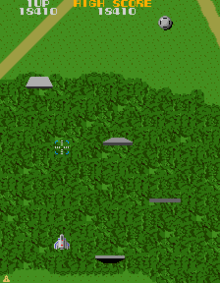Super Xevious
| Super Xevious | |
|---|---|
|
Japanese flyer for Super Xevious. | |
| Developer(s) |
Namco Dempa Shinbunsha |
| Publisher(s) |
|
| Designer(s) | Masanobu Endō |
| Platform(s) | Arcade, Nintendo DS, PlayStation, X68000 |
| Release date(s) |
Arcade
X68000
|
| Genre(s) | Vertical scrolling shooter |
| Mode(s) | Up to 2 players, alternating turns |
| Cabinet | Upright, cabaret, and cocktail |
| Arcade system | Namco Galaga |
| CPU | 3x ZiLOG Z80 @ 3.072 MHz |
| Sound | 1x Namco WSG @ 3.072 MHz, 1x Namco 54XX @ 1.536 MHz |
| Display | Vertical orientation, Raster, 224 x 288 resolution |
Super Xevious (スーパーゼビウス Sūpā Zebiusu) is a vertical scrolling shooter arcade game that was released by Namco in 1984. It runs on Namco Galaga hardware, and as its name suggests, it is the sequel to Xevious (which was released two years earlier). It was later ported to the Sharp X68000 in 1987, and was also included in the compilation game Namco Classic Collection Vol. 1, as well as Xevious 3D/G+ and Namco Museum DS.
Gameplay

The gameplay is very much like that of the original Xevious except this time it is a little more difficult. Several new enemies have also been introduced (including a silver Galaxian flagship, a rare silver Galaga "scorpion" ship, two jet planes, a helicopter, and a dark yellow Tank Battalion tank). Some of these enemies will reset the player's score back to 0 if they are destroyed - and the hidden "Sol Citadel" towers and Rally-X Special Flags are also located in different places.
Ports
The game was re-released as Xevious 2 by Spotlight Software and distributed by Cinemaware in the compilation BrainBlasters with Bombuzal for the Amiga. This compilation was reviewed in 1991 in Dragon #165 by Hartley, Patricia, and Kirk Lesser in "The Role of Computers" column. The reviewers gave BrainBlasters 5 out of 5 stars.[1]
Soundtrack
The game's electronic chiptune music was composed by Yuriko Keino and Junko Ozawa.[2] Former Happy End and Yellow Magic Orchestra member Haruomi Hosono recorded an arranged dance/synthpop version of the game's theme tune,[3] which was released in Japan by Alfa Records' Yen label as a 12" single on August 29, 1984.[2] The single was also released in Europe by Pick Up Records that same year.[3]
References
- ↑ Lesser, Hartley; Lesser, Patricia; Lesser, Kirk (January 1991). "The Role of Computers". Dragon (165): 47–55.
- 1 2 "Super Xevious (12" Single)". VGMdb. Retrieved 7 August 2012.
- 1 2 "Haruomi Hosono – Super Xevious". Discogs. Retrieved 7 August 2012.
External links
- Super Xevious at the Killer List of Videogames
- Super Xevious at the Arcade History database
